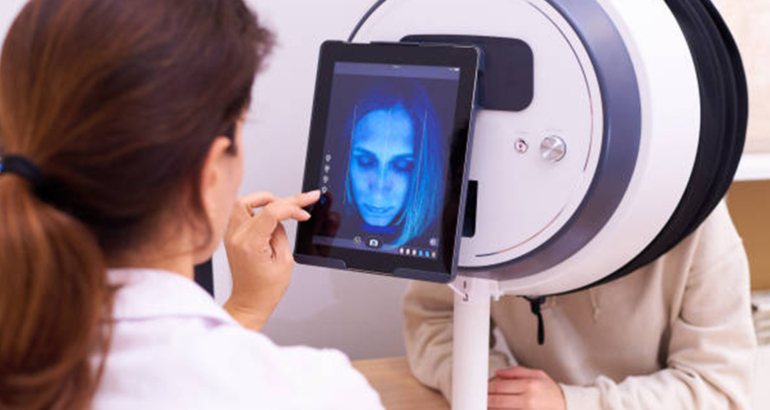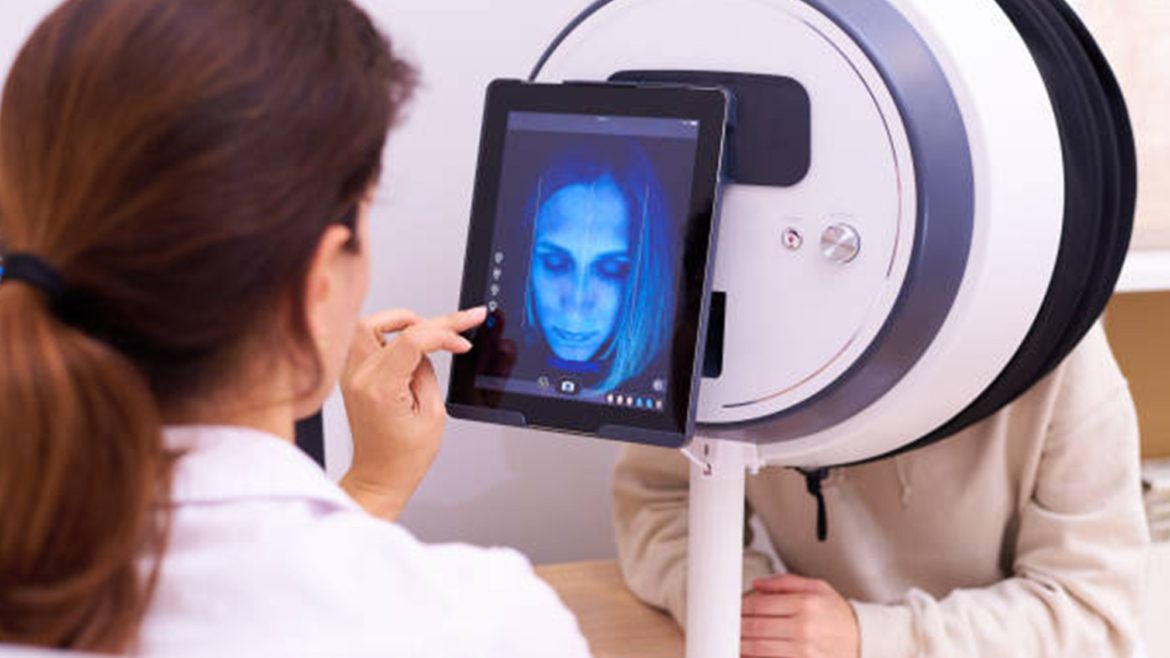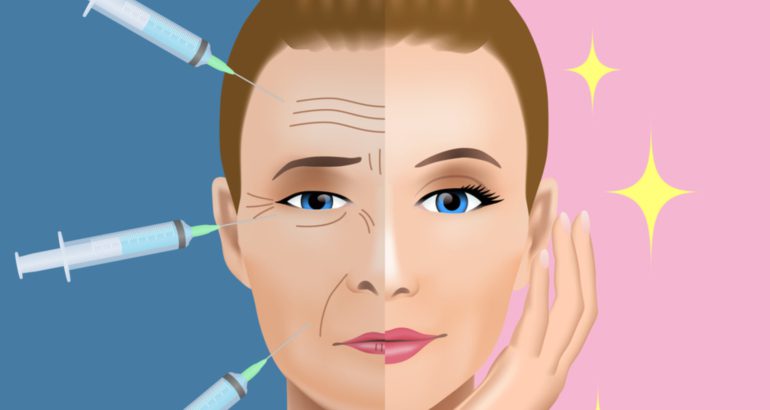
What is a Dermaplaning Facial?
A dermaplaning facial is a cosmetic procedure that uses a surgical scalpel to gently scrape off dead skin cells and peach fuzz from the surface of your skin. The goal is to make your skin appear smooth, youthful, and radiant. A licensed esthetician, dermatologist, or cosmetic surgeon typically performs this procedure. It is often used to prepare the skin for more invasive procedures such as laser treatments and chemical peels.
Benefits of Dermaplaning
- Exfoliation can result in a brighter and smoother complexion by removing dead skin cells.
- Removing peach fuzz can help get rid of soft facial hair that traps dirt and oils, giving the skin a more refined and smoother appearance.
- Skincare products can penetrate more deeply after exfoliation, as it removes the top layer of dead skin.
- By creating a flat and even surface on the skin, exfoliation makes makeup application easier.
- Regular exfoliation can reduce the visibility of acne scars and fine lines over time.
- Exfoliation is a great option for people sensitive to chemicals found in peels or other exfoliating products, as it does not involve any chemicals.
- Unlike some other skin treatments, the results of exfoliation can be seen immediately after the procedure, providing instant gratification.
Downtime needed for this treatment
Dermaplaning has the benefit of requiring a short recovery time, allowing individuals to return to their daily activities soon after the procedure. Although there may be some slight redness or sensitivity immediately following the treatment, these symptoms typically disappear within a day or a few hours. Dermaplaning is a non-invasive procedure, which differentiates it from chemical peels or laser treatments, making it an attractive option for those seeking effective exfoliation without significant downtime.
However, it is crucial to safeguard the skin from direct sunlight exposure after the procedure. Using broad-spectrum sunscreen with an SPF of 30 or higher is recommended, as the skin can be more prone to sunburn and damage. Consulting with a professional before choosing dermaplaning is essential to determine if it is appropriate for your skin type and to discuss any particular risks or side effects related to your skin condition, as with any cosmetic procedure.
How long does it take to perform a dermaplaning add-on during a facial?
A typical dermaplaning session usually takes around 20 to 30 minutes. The professional performing the procedure meticulously covers the whole face during this time, carefully removing dead skin cells and peach fuzz. Dermaplaning is a convenient option for people seeking an effective exfoliation method that doesn’t require significant time commitments because the procedure is relatively quick.
If dermaplaning is being combined with other treatments, such as a facial or a chemical peel, the total time spent in the treatment session will be longer. To get an accurate estimate of the time required for your specific treatment plan, it’s always best to consult with the provider beforehand.
Can dermaplaning be added to microdermabrasion or Hydrodermabrasion facial?
It’s feasible to integrate dermaplaning into both hydrodermabrasion and microdermabrasion procedures, which could potentially enhance the overall outcomes of facial rejuvenation treatments. By combining these procedures, a more comprehensive approach to skin renewal and exfoliation can be achieved, as they target different layers and facets of the skin. The following are some ways in which they complement each other:
Dermaplaning and Microdermabrasion
Microdermabrasion is a mechanical exfoliation technique that involves the use of fine crystals or a diamond tip to eliminate the outermost layer of dead skin cells from the epidermis. Another technique called dermaplaning can be combined with Microdermabrasion to get rid of the top layer of dead skin along with fine vellus hair, allowing for a more profound exfoliation. The usual sequence involves performing dermaplaning first, which removes the peach fuzz and the very top layer of dead skin. This enhances the effectiveness of microdermabrasion by allowing it to penetrate more deeply and uniformly.
Dermaplaning and Hydrodermabrasion
Hydrodermabrasion is an advanced skincare technique that utilizes a combination of water and oxygen to gently exfoliate the skin. This process also involves the application of specially-formulated serums that are designed to address various skin types and concerns. In contrast to traditional microdermabrasion, this method is gentler on the skin. Dermaplaning can improve serum absorption by removing dead skin and hair, which enhances serum penetration when combined with this technique.
Considerations
- Combining various skin treatments can lead to significant exfoliation and improve the skin’s texture and tone. However, it is essential to consider the individual’s skin type, sensitivity, and any specific skin conditions to prevent over-exfoliation or irritation.
- It is usually recommended to have these treatments combined by experienced professionals who can assess whether the combination is suitable for your unique skin needs and concerns.
- Aftercare is crucial because combining treatments can make the skin more sensitive to sunlight and more prone to irritation. A good skincare routine, including the use of moisturizers and sun protection, is essential to promote the skin’s healing and maximize the benefits of the treatments.
Seeking advice from a medical professional can assist in determining the best approach to combining these treatments based on your skin type and goals.
What skin conditions warrant a skin consult with a doctor before a dermaplaning facial?
Dermaplaning is a safe and effective treatment for many people, but there are certain skin conditions that may make the treatment less suitable or riskier. If any of the following conditions apply to you, it is recommended that you consult with a skincare specialist or dermatologist before undergoing this treatment:
- Active or Cystic Acne: Dermaplaning over active breakouts can cause irritation and exacerbate bacteria, leading to more acne.
- Sensitive Skin: People with highly sensitive skin might experience excessive redness and irritation after the treatment.
- Rosacea: Dermaplaning can worsen redness and irritation, especially during active flare-ups.
- Eczema or Psoriasis: This treatment can cause discomfort, irritation, and flare-ups if performed over these areas.
- Skin Infections: This treatment may aggravate or spread conditions like cold sores, warts, or fungal infections.
- Skin Cancer: Dermatologists recommend avoiding this treatment over areas with skin cancer or precancerous conditions to prevent complications.
- Recent Chemical Peels or Laser Treatments: The skin may be too sensitive for immediate dermaplaning after these treatments.
- Sunburn: Dermaplaning on sunburned skin can increase irritation and hinder the healing process.
- Accutane Use: Due to the heightened risk of scarring and sensitivity, it is advised to wait before undergoing this treatment after Accutane treatment.
Waiting Period Before Dermaplaning
It is generally advised to wait for at least six months after completing a course of Accutane before undergoing dermaplaning. This is because Accutane can impact the skin’s healing abilities, causing increased sensitivity.
The length of the waiting period after chemical peels or laser treatments can vary depending on the intensity of the treatment. For lighter peels, a few weeks may be sufficient, but for deeper treatments, it is advisable to wait for a few months. It is important to always follow the guidance of the professional who performed the previous treatment.
If you have experienced active acne, eczema, or psoriasis flare-ups, it is crucial to wait until your skin has fully healed and is no longer inflamed or irritated. The duration of this period can vary widely based on individual skin conditions and the healing process.
After a sunburn, it is important to wait until the burn has fully healed, and any peeling has stopped. The waiting period for this can range from several days to a few weeks, depending on the severity of the sunburn.
To ensure that dermaplaning is safe for you and to determine the optimal timing for the procedure based on your skin’s condition and history, it is crucial to consult with a skincare professional or dermatologist. The precise waiting time can vary depending on individual circumstances and the severity of the specific condition.
Why shall I consider doing Dermaplaning at your Medical Spa in Danville?
Dr Anuja Garg has more than 15 years of experience treating patients with various skin concerns and other medical issues. It is recommended that you have the treatment performed at our Medical Spa in the Danville area, under the supervision of a doctor, for several reasons:
- Expertise and Experience: Dr Garg closely collaborates with our esthetician, who performs the procedure, to minimize the risk of cuts, irritation, and infection. Additionally, they can evaluate your skin type and condition to determine whether the treatment is appropriate for you.
- Hygiene and Sterilization: Our Medical Spa in the Danville area provides a sterile environment and employs medical-grade tools, reducing the risk of contamination and infection.
- Customized Treatment: Dr Garg works closely with our esthetician to personalize the treatment to your specific skin needs and issues. They may also combine it with other treatments for optimal results.
- Precaution and Risk Management: Dr Garg can help identify contraindications and manage any potential risks associated with dermaplaning, especially for individuals with skin conditions that might complicate the procedure.
- Post-Treatment Care: They provide expert advice on aftercare to ensure proper healing and maximize the benefits of dermaplaning, including recommending safe-to-use products after the procedure.
Overall, having a medical professional like Dr. Anuja Garg supervise the procedure at our medical spa in the Danville area ensures a safer, more efficient treatment, and a customized approach to skincare, making it the preferred choice for this treatment.
Where can I get the list of all Medical Spa treatments available at your facility serving the Danville, CA area?
You can look at our Medical Spa page to learn more about the treatment. You can check all the treatments and prices at this link.
Reviews
I have been using the services of Dr Anuja Garg as my physician and weight loss specialist since March 2024.
We decided to follow the clinic weight loss program after taking all the necessary precautions. 10 weeks in; I have lost rather effortlessly 55 pounds.
I fully trust Dr Garg and her team to monitor my health during my weight loss journey and beyond.
I highly recommend the clinic.
Overall a good experience, I will recommend this if you want to get medicals done for immigration



